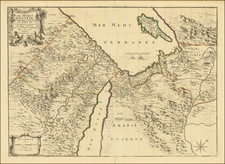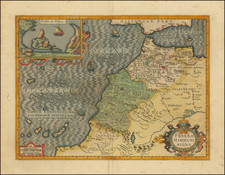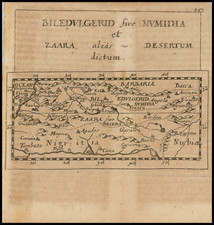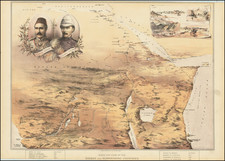Nice example of Paolo Forlani's map of Egypt, published in 1566, generally regarded as the first modern map of Egypt.
Abraham Ortelius would later use Forlani's map as the pro-type for his map of Egypt: www.raremaps.com/gallery/detail/35175bp
Forlani was among the leading Venetian map makers active in the 1560s and 1570s. His work is often referred to as part of the "Lafreri School" of mapmakers.
Paolo Forlani
As noted by Ashley Baynton Williams (Map Forum):
Paulo Forlani, from Verona, . . . based himself in Venice. Forlani is unusual within the school because he was one of the few to combine the talent of mapmaking and engraving, while also infrequently acting as a publisher and mapseller. He was much-sought after as an engraver and mapmaker, particularly as he was adept at the difficult art of engraving lettering. Consequently, he was employed by four of the leading publishers of the period to prepare maps for them -Giovanni Francesco Camocio, Ferrando Bertelli and Bolgnini Zaltieri from Venice, and Claudio Duchetti from Rome.
However, there is precious little documentary evidence for Forlani's activities. For example, only one of his maps was the subject of an application for a privilege. As a result, much that is known about his activities has been reconstructed from the maps with which he was associated. However he did not sign all the maps he engraved.
While writers from earlier this century credited maps to Forlani based on particular characteristics, the first serious work on Forlani's style that I know of was published by H.A.M. Heijden as part of his study of an anonymous Italian map of the Netherlands.
Three years later, the study of Forlani career was greatly advanced with the publication of David Woodward's listing of Forlani's maps and prints. Woodward listed 144 items (97 separate pieces, with their later states listed separately) of which no less than eighty items do not bear Forlani's name, but could be attributed to him solely on stylistic grounds.
* * *
From 1560 to 1564, Forlani seems to have worked mostly for Camocio, but by about 1562 Forlani was also working for Ferrando Bertelli, doing increasing amounts of work for him. In the period 1565 and 1566, Forlani also engraved a number of items for Zaltieri. In 1570 and 1571, Forlani was engraving maps for Claudio Duchetti, although these latter are almost all unsigned.
* * *
The last stages of Forlani's career are somewhat uncertain; he was clearly active up until to and including 1571. The years 1568, 1570 and 1571 seem to have been particularly prolific years for him. Then there is a break of three years in which no new dated material is known, while three maps survive dated 1574, published by Simon Pinargenti. All three have re-engraving evident in the titles, and it is plausible that the plates were prepared by Forlani in 1570 (the Americas, for example) or 1571, and then re-issued by Pinargenti.
Antonio Lafreri
Antoine Lafréry, better known as Antonio Lafreri (1512-77) was born in Besançon. His earliest work in Rome dates to about 1544. From his workshop on the Via del Parione, he produced many important publications. In 1553, he founded a company with his mentor, Antonio Salamanca, which would operate until 1562. Thereafter, from 1562 to Lafreri's death in 1577, he conducted business under his own name.
While the present map proves that Lafreri was quite capable of devising his own first rate maps, he was primarily a dealer and publisher, rather than an artisan in his own right. He carried a vast stock of maps and prints made by other printers from both Rome and Venice. He became known for producing IATO (Italian-Assembled-To-Order) atlases, each unique composite atlases featuring a selection of fine Italian maps, made to the tastes of individual clients. Pre-dating Abraham Ortelius, these 'Lafreri Atlases' and their contents, represent the birth of the modern atlas. Owing to the popular acclaim of these atlases, while the term was never used during this period, the Italian maps from this era are today often said to be of the 'Lafreri School'.
As noted by Ashley Baynton Williams:
The reason that Lafreri's name is now used as an umbrella term for the school is because he issued a catalogue of his stock in 1572, entitled 'Indice Delle Tavole Moderne Di Geografia Della Maggior Parte Del Mondo ...'. This catalogue is very similar, both in title and contents, to bound collections of maps with an engraved title Tavole Moderne Di Geografia De La Maggior Parte Del Mondo Di Diversi Autori. Accordingly bound collections with the engraved title were attributed to Lafreri, and thence his name became associated with the group as a whole. Some writers have attributed the title to Duchetti, but there seems no good reason to challenge Lafreri's role.
Having said that much of his cartographic output was derivative, it should be said that Lafreri was very active as a publisher and seller of broadsheet 'news-maps', maps illustrating important contemporary events. Of these, by far the most popular was the siege of Malta by the Turks in 1565, and Lafreri produced maps of the island, the fortifications of Valetta, and depicting various stages in the siege, including the Turkish retreat. Another popular subject was the battle of Lepanto, on October 7th 1571, in which the Turkish fleet was routed by a combined Venetian, Spanish and allied fleet. Just over a month after the battle, on November 14th, Lafreri published a detailed plan of the battle - a remarkably short space of time considering the intricacies of engraving such an image.
Lafreri was also the founder of a cartographic dynasty. His nephew Claudio Duchetti, born in France as Claude Duchet (d. 1585), who had worked closely with his uncle, inherited the business in 1577 upon Lafreri's death. Duchetti published many new editions of Lafreri's maps. When Duchetti passed, his main heir, Giovanni Orlandi, inherited his plates and continued publishing 'Lafreri School' maps until the early years of the 17th Century
Paolo Forlani (fl. ca. 1560-1571) was a prolific map engraver based in Venice. All that is known of his life are his surviving maps and prints, of which there are almost 100 (185 with later states included in the total). He also produced a globe and two town books. It is likely he came from Verona and that he died in Venice in the mid-1570s, possibly of the plague.











![Egypt [with] Abyssinia](https://storage.googleapis.com/raremaps/img/small/71788.jpg)
![Il Gerbi [Borj El Kebir, Tunisia]](https://storage.googleapis.com/raremaps/img/small/73716.jpg)

